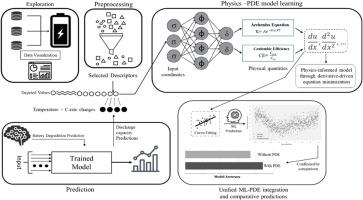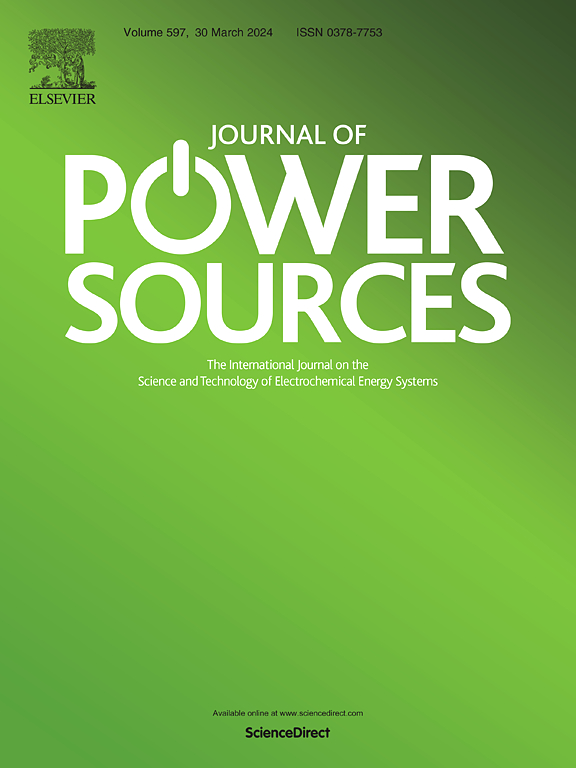Decoding degradation: The synergy of partial differential equations and advanced predictive models for lithium-ion battery
IF 8.1
2区 工程技术
Q1 CHEMISTRY, PHYSICAL
引用次数: 0
Abstract
Recent advancements in machine learning (ML) algorithms have transformed Li-Ion battery analysis, focusing on crucial parameters like State of Charge (SOC), State of Health (SOH), and Remaining Useful Life (RUL). However, due to increasing computational complexity and lack of fundamental process understanding within the developed models, conventional predictive tools suffer its integration in real world applications. To address this gap, our study introduces a hybrid modeling approach consisting of two stages. In the first stage, we apply various machine learning algorithms to predict battery degradation using empirical data, focusing on capturing the initial patterns of battery behavior under different operating conditions. In the second stage, we enhance these predictions by integrating Partial Differential Equations (PDEs) that incorporate fundamental physical principles governing battery performance. This combination creates a physics-informed ML model that bridges the gap between empirical data and theoretical understanding. The integration of PDEs significantly improves the model's accuracy in predicting both degradation and discharge capacity. Our results demonstrate a marked enhancement in key performance metrics, with the hybrid model achieving a Mean Square Error (MSE) of 0.2091, Root Mean Square Error (RMSE) of 0.4572 and Mean Absolute Error (MAE) of 0.2555. In comparison, the errors from the initial stage-one ML predictions were substantially higher, with MSE, RMSE, and MAE values of 10.3648, 3.2194, and 0.7392, respectively. These findings highlight the hybrid model's effectiveness and its potential to significantly improve battery management practices, ultimately contributing to the extension of battery lifespan.

解码退化:偏微分方程与锂离子电池先进预测模型的协同作用
机器学习(ML)算法的最新进展改变了锂离子电池分析方法,重点关注充电状态(SOC)、健康状态(SOH)和剩余使用寿命(RUL)等关键参数。然而,由于计算复杂性不断增加,以及对所开发模型的基本过程缺乏了解,传统预测工具在实际应用中难以整合。为了弥补这一不足,我们的研究引入了一种由两个阶段组成的混合建模方法。在第一阶段,我们应用各种机器学习算法,利用经验数据预测电池退化,重点是捕捉不同工作条件下电池行为的初始模式。在第二阶段,我们通过整合偏微分方程 (PDE) 来增强这些预测,偏微分方程结合了支配电池性能的基本物理原理。这种组合创建了一个物理信息 ML 模型,在经验数据和理论理解之间架起了一座桥梁。PDEs 的集成大大提高了模型预测降解和放电容量的准确性。我们的研究结果表明,混合模型的主要性能指标有了显著提高,平均平方误差 (MSE) 为 0.2091,均方根误差 (RMSE) 为 0.4572,平均绝对误差 (MAE) 为 0.2555。相比之下,第一阶段 ML 预测的误差要大得多,MSE、RMSE 和 MAE 值分别为 10.3648、3.2194 和 0.7392。这些发现凸显了混合模型的有效性及其显著改善电池管理实践的潜力,最终有助于延长电池的使用寿命。
本文章由计算机程序翻译,如有差异,请以英文原文为准。
求助全文
约1分钟内获得全文
求助全文
来源期刊

Journal of Power Sources
工程技术-电化学
CiteScore
16.40
自引率
6.50%
发文量
1249
审稿时长
36 days
期刊介绍:
The Journal of Power Sources is a publication catering to researchers and technologists interested in various aspects of the science, technology, and applications of electrochemical power sources. It covers original research and reviews on primary and secondary batteries, fuel cells, supercapacitors, and photo-electrochemical cells.
Topics considered include the research, development and applications of nanomaterials and novel componentry for these devices. Examples of applications of these electrochemical power sources include:
• Portable electronics
• Electric and Hybrid Electric Vehicles
• Uninterruptible Power Supply (UPS) systems
• Storage of renewable energy
• Satellites and deep space probes
• Boats and ships, drones and aircrafts
• Wearable energy storage systems
 求助内容:
求助内容: 应助结果提醒方式:
应助结果提醒方式:


